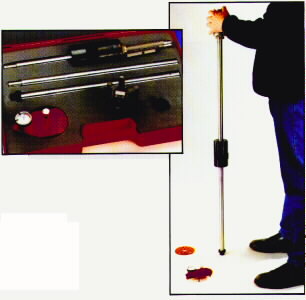 

BRE SCREED TESTER
Measures Screed Soundness as early as 14 days after laying
Description
Dense floor screeds which on visual
inspection appear to be sound, i.e.able
to withstand imposed loads and traffic,
may in fact be sub-
standard.Specifications often state that
the cement /sand screed should be
semi-dry, a consistency which when
manually compressed may result in the
lower layers being insufficiently
compacted. This may cause the screed
to fail under the impact of heavy traffic
or furniture movement. Subsequent
remedial work on the screed is often
costly and time consuming.
The tester is designed to measure
screed soundness as early as 14 days
after laying. The device consists of a
Im long, cylindrical guide rod, along
which an annular weight of 4 kg travels
when released. At the bottom of the
guide rod the weight strikes the collar
of a case-hardened steel anvil which
transmits the impact to the selected
area of the screed.
Research has shown that four
successive impact blows on the same
spot are sufficient to test the soundness
of the screed. Any area where the
impacts produce an indentation of
3 mm or less can be considered sound,
according to current data. Where the
indentations are greater than 5 mm the
screed is considered and may fail when
in use. BS8203 gives guidance on the
type of use of a floor and its associated
acceptance limits after four drops of the
weight. The depth of indentation is
measured with a purpose-made
mechanical gauge or a more
sophisticated direct-reading digital
electronic gauge which is available if
required.
Specification
Drop weight = 4 kg
Drop height = 1000 mm
Contact area of anvil 500 mm2
Overall dimensions
of carrying case 515x375x125 mm
Weight of BRE screed
tester in case 9.75 kg
|